“Charles Mason was the scientific spirit of the party—a cool, observing, painstaking, plodding man, slow in his processes and reliable in his conclusions, and the bond of friendship between himself and Dixon was that of two unequal minds admiring the superiorities of each other. They had already proceeded together to the Cape of Good Hope on two occasions to study an eclipse and an occultation. Mason liked Dixon for his ready spirits, almost improvident courage, speed with details, and worldly bearing. Though little is known of their memories now, because they left us no prolific records and spent much of the period of service among us in the midst of the wilderness or in the reticence required for mathematical calculation, yet they were the successors of Washington in the surveying of the Alleghany ridges. Their survey was reliable; the line was true. How much superior does it stand to-day to the line of thirty degrees thirty minutes, which is the next great political parallel below it, and was partly run only a few years afterwards! Up to their line for the next hundred years flowed the waters of slavery, but sent no human drop beyond, which did not evaporate in the free light of a milder sun. God speed the surveyor, whoever he be, who plants the stakes of a tranquil commonwealth and leaves them to be the limit of bad principles, the pioneer line of good ones!
“Charles Mason had spent many years of his life, up to his old age, experimenting with timepieces of his own invention. Many years before, Sir Isaac Newton had called the attention of the British Government to the necessity for an accurate portable time-keeper at sea, to determine longitude, and in 1714 Parliament offered a reward of 20,000 pounds sterling for such a chronometer. Thenceforward for fifty years the inventive spirits of England and the Continent were secretly at work to produce a timepiece which would deserve the large reward, amongst them Charles Mason, who labored with such perfect discretion and uncommunicative self-reliance that none knew, none will ever know, the motive principle he employed or the enginery he devised. While he was working at this survey, near the spot at which we stand, the Board of Award gave the L20,000 to one John Harrison, almost at the very instant when Mason and Dixon’s line was begun. This you can confirm by any history of Horology. Charles Mason lived down to the year 1787, surviving Dixon, who had died in England ten years previously, and he was known to say to the end of his days, to people resident in Philadelphia, that a child had eaten up L20,000 belonging to him at a single mouthful.
“The child whom the neighborhood at that time accused of this act was known in later life as Fithian Minuit, babe of a woman of mixed English and Finnish-Dutch descent, who came from the fishermen’s town of Head of Elk, a few hours jog to the southward, to sell fish to the surveying camp. She was a woman of mingled severity of features and bodily obesity, uniting in one temper and frame the Scandinavian and the Low Dutch traits, ignorant good-humor, grim commerce, and stolid appetite. Her baby was the fattest, quaintest, and ugliest in the country; ready to devour any thing, to grin at any thing, go to the arms of everybody, and, in short, it represented all the traits of the Middle State races—the government of the members, including the brain, by the belly.




